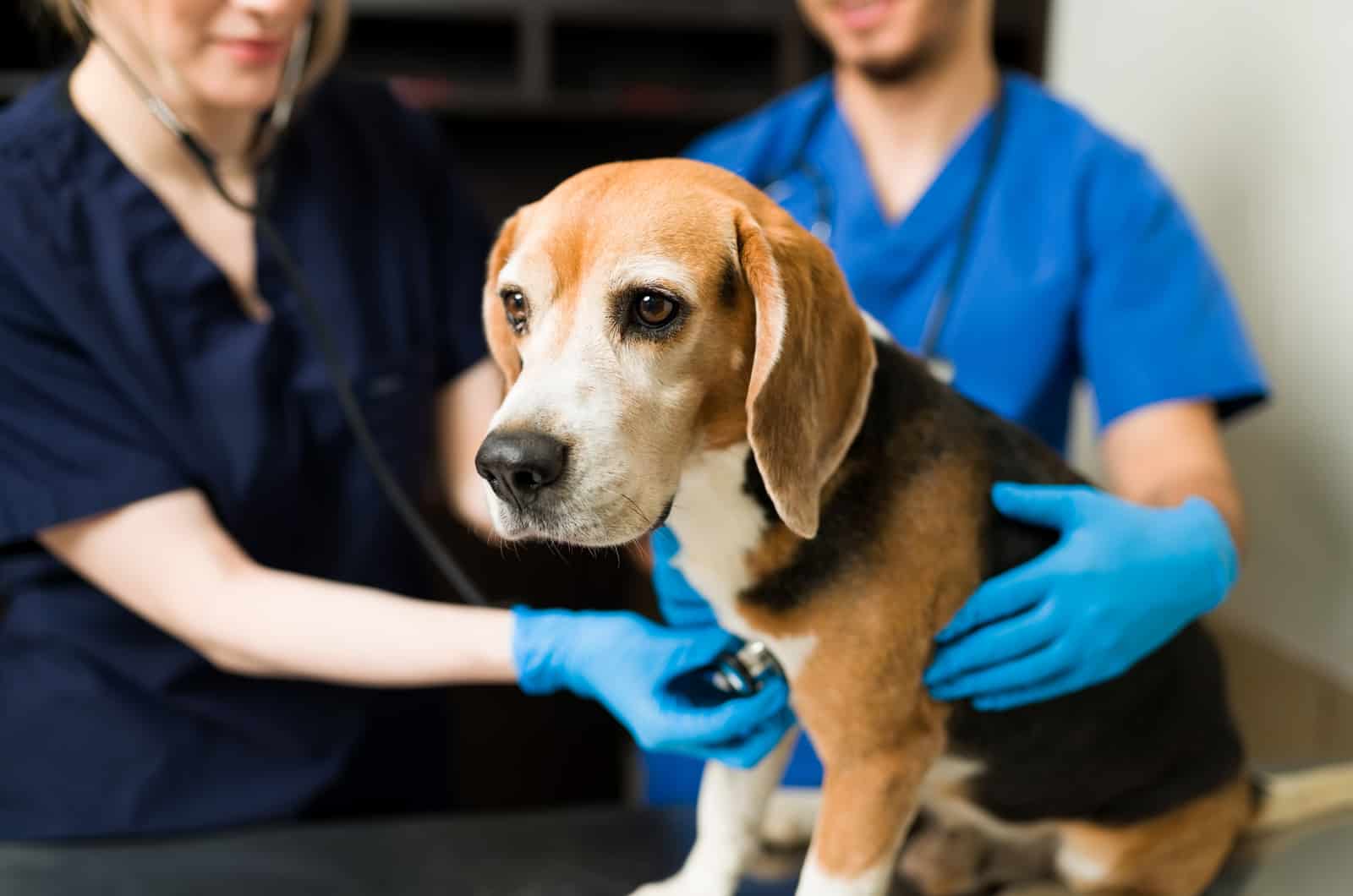Hello to all worried dog owners who are wondering if their lovely companion is having a fever or not. Hello to all curious owners too, who are wondering what is a normal dog temperature and what is not!
Well, before we say anything about this dog temperature chart, we first want to say that dog body temperature works the same as human body temperature. You experienced high temperature, low temperature, or high fever at least once in your life, so you know what I’m talking about.
The dog temperature chart describes the normal body temperature range in dogs, as well as which body temperature is considered unhealthy and when is the time to call your veterinarian.
So, without further ado, let’s get straight into the dog temperature chart!
Dog Temperature Chart Up Close
To keep it simple, here is a close-up of the dog temperature chart. Each dog’s body temperature measurement is written in Fahrenheit, but they can also be written in Celsius (depending on where you are located).
[table id=556 /]
This dog temperature chart can be your go-to pet care guide because it gathers all the possible dog body temperatures in one place!
What Is The Normal Temperature For A Dog?

The normal temperature for a dog is between 101° and 102,5°F but it depends on the dog size category, as well as the dog breed.
When compared to large dogs, small dogs are more likely to feel cold, but they endure warmer environmental temperatures than large dogs.
Dog breeds that inherit thick, double-layered coats have a higher risk of heat strokes when it is hot outside, while those with short coats have a lower risk of heat stroke. Additionally, brachycephalic dog breeds like the French Bulldog and the Pug have an increased risk of heat stroke due to breathing problems. The same goes for obese dogs.
Here’s what I’m talking about:
Small Dog Temperature Chart
Small dog breeds are those pooches that weigh under 20 pounds and their normal body temperature is 101° to 102,5°F.
Small dogs feel well when environmental temperatures are between 60° and 70°F. Once the temperature outside reaches anywhere between 75° and 85°F, then it is considered unsafe for small dogs to be too long outside — especially for small fluffy dog breeds.
Hot environmental temperatures between 90° and 110°F can be life-threatening to small dogs and it is not recommended that they spend time outdoors during such warm weather. Moreover, hot weather makes concrete even hotter, so your dog can develop burns on its paw pads if it walks over the hot concrete.
In contrast to high temperatures, small dogs feel cold when the environmental temperature drops to 32°F, but they will do good with a jacket and a sweater. However, if the temperature drops from 23° to 5°F then the small dog might freeze to death! You will notice that small dog breeds like Chihuahuas, Shih Tzus, Maltese, and Dachshunds shake when they feel cold, but also when they are suffering from a high fever.
Medium Dog Temperature Chart
Medium dogs weigh between 21 to 50 pounds on average and their normal body temperature is between 101° and 102,5°F.
The majority of medium-sized dogs have fun in the Sun when temperatures are between 60° and 70°F. Every environmental temperature that is higher than 80°F is considered risky for medium-sized dogs.
When it comes to cold weather, medium dogs are sturdier than small dogs and they can play safely when the outside temperature drops to 23°F, but they will need a warm sweater or paw pad protection. Just like hot concrete, keep in mind that cold concrete and ice can also burn the dog’s paw pads.
Medium-sized dogs such as Siberian Huskies, Australian Shepherds, Chow Chows, and American Eskimo dogs thrive in cold weather but may have health problems in warm climates.
Large Dog Temperature Chart
The normal body temperature for large dogs that weigh over 50 pounds is between 101° and 102,5°F.
These big pooches are at higher risk of having a heat stroke when they are exposed to environmental temperatures above 70°F. When hot, large breed puppies breathe fast which is the body’s natural way of getting rid of excess heat. Providing your large dog with cool water, and shade, and turning on the AC will help it cool down.
Most large dogs do well in cold weather due to their sturdy bodies. So, large dogs won’t feel too cold when the temperature drops from 50° to 14°F.
Big fluffy breeds like Samoyeds and Alaskan Malamutes enjoy the cold weather the most! Dog training and physical activity will help the dog feel warm during cold weather!
What Is An Unhealthy Temperature For A Dog?

An unhealthy temperature for a dog is when the thermometer shows temperatures above 103-104°F when it is highly advised to seek veterinary help.
Note that an unhealthy dog’s body temperature does not always mean an elevated temperature. Dogs are also at risk of developing hypothermia if the weather outside is too cold or if they are not kept warm after surgery. Some diseases may also lead to the dog developing hypothermia. That said, an unhealthy dog’s body temperature is below 98-99˚F.
Do not mistake your dog’s reaction to vaccination for illness. In most cases, this is not considered an unhealthy dog body temperature — it is your dog’s body reacting to the vaccine and acquiring active immunity.
This also happens to people; the majority of folks that got vaccinated against COVID-19 have experienced elevated temperatures or a high fever a few days after the vaccination.
However, if the elevated temperature stays so for more than three days, or your dog’s temperature reaches concerning parameters, you should call your veterinarian immediately.
Learn more on dog behavior after vaccination.
What Is A Fever?

In short, a fever means an elevated temperature of the body. It happens when the dog’s immune system finds out that some intruders such as bacteria and viruses have found their way into the dog’s body. So, the dog’s body turns on the heat as a natural defense mechanism.
High fever in dogs is normal in a way — the dog’s body is reacting and trying to handle the infection on its own.
However, too high of a fever can potentially damage the dog’s internal organs which can result in the dog dying. This is why a high dog’s fever should not be overlooked — it should always be monitored and treated.
Dogs with high fever show symptoms such as shivering, similar to how we feel when we are sick.
What Are The Symptoms Of A Fever In A Dog?
More often than not, your puppy’s ears and its little nose are going to be warm to the touch. Depending on what is causing the high fever, your pup might sneeze a lot too.
When high fever kicks in, affected dogs pant and shiver. Some dogs may attempt to cough, whereas others may throw up yellow or white, foamy content.
Your pup with a high fever may exhibit red and watery eyes and a runny nose. Because your pup’s immune system is triggered by the body’s elevated temperature, it is going to fight to get rid of whatever is causing the high fever. This may exhaust your pup more, so it will become lethargic and sleepy.
What Are Some Ways To Tell If A Dog Has A Fever?

The vast majority of dog owners fail to immediately notice when their dog is experiencing a high temperature. Sometimes it is difficult to tell whether or not your dog is having a high fever. The best way to find out is by measuring your dog’s body temperature with a digital thermometer or what we call a rectal thermometer in this case. However, if you do not have one by your side, there are other ways to find out if your pup has a high fever.
The first way to tell if your dog is having a fever is by touching its head, ears, and nose. Your dog’s head is hot to the touch if it is suffering from a high fever.
Dogs with high fever usually have glossy, red, and watery eyes, as well as runny noses. In contrast to your dog having cold ears, a high fever will make its ears very warm. So, touch your dog’s ears to determine if it has a fever.
The next thing you want to do is to observe your dog. Just like us, dogs with high fever are less energetic, weak, and lethargic; they don’t seem interested in playing or cuddling. Your dog with a fever is not eating properly; its appetite is low. However, these signs resemble any kind of illness in dogs, with or without the fever.
While a high body temperature does not always mean that your pup is having a high fever, it should still be monitored.
Elevated body temperature in dogs can lead to a high fever if the dog is suffering from a certain illness, but it can also indicate that the dog is overheating, due to hot weather.
Can I Use A Human Thermometer On A Dog?
Of course, you can, but I am assuming that you are aware of where your thermometers are going to go. If you don’t mind dog poop on your thermometer, then go ahead.
But, please keep in mind that measuring dog temperature depends on the size of your dog — you can’t just stick the whole thermometer in the dog’s rectum.
How To Measure Dog’s Temperature
Dog body temperature is measured by sticking a digital thermometer into its bum!
Avoid using a glass human thermometer because it can break and hurt your dog if it starts wiggling and moving. Moreover, some glass thermometers still contain mercury, which is highly toxic and dangerous for both dogs and humans.
Also, make sure to clean your dog’s rectal area before measuring its rectal temperature. Use petroleum jelly to lubricate the dog’s rectum so that the digital thermometer doesn’t cause friction and redness. Don’t worry, petroleum jelly is safe to use when measuring the dog’s temperature, we always use it in the clinic!
If you don’t have petroleum jelly laying around in the house, you can substitute it for vegetable or olive oil.
For small dogs, a digital thermometer should be inserted no more than an inch inside the rectum. When it comes to large dogs, a digital thermometer can be inserted from 2 to 3 inches inside the rectum.
Hold the digital thermometer inside the dog’s rectum until you hear the beeping sound. That was easy, wasn’t it?
Make sure to reward your dog with yummy treats for enduring the awkward body temperature measuring process!
After you’re done measuring your dog’s body temperature, make sure to clean the thermometer thoroughly with 75% alcohol.
Should I Call The Vet If My Dog Has A High Fever?

That would be a yes – you must call your veterinarian if you notice that your dog is under the weather and that it has a high fever. Your vet will perform a series of health checks to determine what is the cause of a high fever in your dog.
Essentially, your dog will be put on antipyretic drugs to reduce the elevated temperature. Depending on the cause, your dog might be given antibiotics or antiviral medicine.
• When talking to your veterinarian, you must answer these questions accurately:
• When did you notice that your dog has a high fever?
• When did you measure your dog’s body temperature?
• How high was your dog’s body temperature?
• How long has your dog had a high fever?
• Are there any other signs that your dog has been showing lately?
Your veterinarian will probably ask you more questions, but these are the clinic’s FAQs when it comes to dogs and high fever.
See Also: How To Comfort A Dog With A Fever
Conclusion
Cold weather, warm weather, surgery procedures, different bacteria, and viruses can all contribute to either a temperature drop or an elevated temperature in dogs. High fever in dogs can also be of unknown origin.
Whatever the cause may be, your dog should have access to cool water 24/7 because it will aid in body rehydration and may provide a cooling effect.
This dog temperature chart will help you link an elevated or low dog body temperature to different conditions that can affect your dog’s health in the long run.
Advice to all pet owners is to seek veterinary care whenever they notice that their dog is feeling under the weather. Sometimes, a high fever is not noticed until the dog starts showing other symptoms such as weakness, inappetence, lethargy, panting, dry heaving, and so on.
Remember to always keep an eye out for your dog and never leave your dog in a hot car! What you consider warm might be too hot for your dog, so be careful!
Related Content
Dog Tongue Color Chart: What Color Is A Sign Of A Healthy Dog?
Dog Poop Color Chart: Full Guide To Your Dog’s Stool
Dog Ear Positions Chart: 5 Ear Positions You Need To Know About
